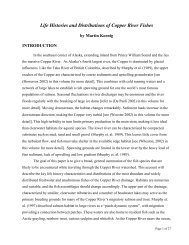Mitigation for the Construction and Operation of Libby Dam
Mitigation for the Construction and Operation of Libby Dam
Mitigation for the Construction and Operation of Libby Dam
You also want an ePaper? Increase the reach of your titles
YUMPU automatically turns print PDFs into web optimized ePapers that Google loves.
PROJECT HISTORY<br />
Montana Fish, Wildlife <strong>and</strong> Park’s (FWP) began to assess <strong>the</strong> effects <strong>of</strong> <strong>Libby</strong> <strong>Dam</strong><br />
operation on fish populations <strong>and</strong> lower trophic levels in 1982. This project established<br />
relationship between reservoir operation <strong>and</strong> biological productivity, <strong>and</strong> incorporated <strong>the</strong> results<br />
in <strong>the</strong> quantitative biological model LRMOD. The models <strong>and</strong> preliminary IRC’s (called<br />
Biological Rule Curves) were first published in 1989 (Fraley et al. 1989), <strong>the</strong>n refined in 1996<br />
(Marotz et al. 1996). Integrated Rule Curves (IRC’s) were adopted by NPPC in 1994, <strong>and</strong> have<br />
recently been implemented, to a large degree, in <strong>the</strong> federal Biological Opinion (BiOp) <strong>for</strong> white<br />
sturgeon <strong>and</strong> bull trout (USFWS 2000). This project developed a tiered approach <strong>for</strong> white<br />
sturgeon spawning flows balanced with reservoir IRC’s <strong>and</strong> <strong>the</strong> NOAA-Fisheries BiOp <strong>for</strong><br />
salmon <strong>and</strong> steelhead.The sturgeon tiered flow strategy was adopted by <strong>the</strong> White Sturgeon<br />
Recovery Team in <strong>the</strong>ir Kootenai white sturgeon recovery plan (USFWS 1999) <strong>and</strong> later refined<br />
in <strong>the</strong> USFWS 2000 BiOp.<br />
A long-term database was established <strong>for</strong> monitoring populations <strong>of</strong> kokanee, bull trout,<br />
westslope cutthroat trout, rainbow trout <strong>and</strong> burbot <strong>and</strong> o<strong>the</strong>r native fish species. Long-term<br />
monitoring <strong>of</strong> zooplankton <strong>and</strong> trophic relationships was also established. A model was<br />
calibrated to estimate <strong>the</strong> entrainment <strong>of</strong> fish <strong>and</strong> zooplankton through <strong>Libby</strong> <strong>Dam</strong> as related to<br />
hydro-operations <strong>and</strong> use <strong>of</strong> <strong>the</strong> selective withdrawal, <strong>the</strong>rmal control structure. Research on <strong>the</strong><br />
entrainment <strong>of</strong> fish through <strong>the</strong> <strong>Libby</strong> <strong>Dam</strong> penstocks began in 1990, <strong>and</strong> results were published<br />
in 1996 (Skaar et al. 1996). The effects <strong>of</strong> dam operation on benthic macroinvertebrates in <strong>the</strong><br />
Kootenai River was also assessed (Hauer et al. 1997) <strong>for</strong> comparison with conditions measured<br />
in <strong>the</strong> past (Perry <strong>and</strong> Huston 1983). The project identified important spawning <strong>and</strong> rearing<br />
tributaries in <strong>the</strong> U.S. portion <strong>of</strong> <strong>the</strong> reservoir <strong>and</strong> began genetic inventories <strong>of</strong> species <strong>of</strong> special<br />
concern. Research on <strong>the</strong> effects <strong>of</strong> operations on <strong>the</strong> river fishery using Instream Flow<br />
Incremental Methodology (IFIM) techniques was initiated in 1992. Assessment <strong>of</strong> <strong>the</strong> effects <strong>of</strong><br />
river fluctuations on Kootenai River burbot fishery was examined in 1994 <strong>and</strong> 1995. IFIM<br />
studies were also completed in Kootenai River below Bonners Ferry, Idaho, to determine<br />
spawning area available to sturgeon at various river flows. Microhabitat data collection specific<br />
to species <strong>and</strong> life-stage <strong>of</strong> rainbow trout <strong>and</strong> mountain whitefish has been incorporated into<br />
suitability curves. River cross-sectional pr<strong>of</strong>iles, velocity patterns <strong>and</strong> o<strong>the</strong>r fisheries habitat<br />
attributes were completed in 1997. Hydraulic model calibrations <strong>and</strong> incorporation <strong>of</strong> suitability<br />
curves <strong>and</strong> modification <strong>of</strong> <strong>the</strong> model code were completed in 1999. The IFIM model is<br />
currently being updated <strong>and</strong> frefined by Miller Ecological Consultants, Inc.<br />
Montana FWP has completed several on-<strong>the</strong>-ground projects since beginning mitigation<br />
activities since 1997. Highlights <strong>of</strong> <strong>the</strong>se accomplishments are listed below <strong>for</strong> each year.<br />
1997 – Montana FWP chemically rehabilitated Bootjack, Topless <strong>and</strong> Cibid Lakes (closed-basin<br />
lakes) in eastern Lincoln County to remove illegally introduced pumpkinseeds <strong>and</strong> yellow perch<br />
<strong>and</strong> re-establish rainbow trout <strong>and</strong> westslope cutthroat trout.<br />
1998 - Montana FWP rehabilitated 200' <strong>of</strong> Pipe Creek stream bank in cooperation with a private<br />
l<strong>and</strong>owner to prevent fur<strong>the</strong>r loss <strong>of</strong> habitat <strong>for</strong> bull trout <strong>and</strong> westslope cutthroat trout. Pipe<br />
Creek is a primary spawning tributary to <strong>the</strong> Kootenai River.<br />
1998 through 2000 - Montana FWP developed an isolation facility <strong>for</strong> <strong>the</strong> conservation <strong>of</strong> native<br />
redb<strong>and</strong> trout at <strong>the</strong> <strong>Libby</strong> Field Station. Existing ponds were restored <strong>and</strong> <strong>the</strong> inlet stream was<br />
enhanced <strong>for</strong> natural outdoor rearing. Natural reproduction may be possible. Activities included<br />
17
















